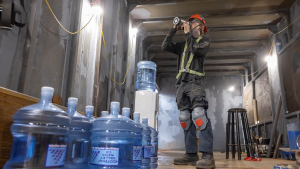The Petrie April 2025 addendum report alleging WorkSafeBC (WSBC) ignores companies that suppress claims to get lower rates is being met with more confusion than clarity.
“We are always happy to work with labour where there is a problem but we have to be able find where the problem is,” said Council of ������ion Associations president Dave Baspaly.
The addendum report provides mainly an overview of all WSBC industries with no honed data on the extent or severity of claims suppression, industry worst offenders or other details.
“These are questions that WSBC might be asking,” suggests BC Building Trades executive director Brynn Bourke, who is aware it happens in her sector but has no data.
It impacts an employee who is at an employer power disadvantage and can be subject to intimidation and threats of job loss.
“What we have noticed is that it is pervasive,” she said.
Baspaly said: “We support the ongoing WSBC system to investigate and penalize cases of employer claim suppression and of fraud of all kinds.”
But, the 15-page Petrie 2025 addendum is short of answers and long on questions.
A bit of history…
In 2018 Paul Petrie was commissioned by the B.C. Ministry of Labour and the Workers’ Compensation Board (WCB) directors to review claims and rehabilitation policy to become more worker-centred. One recommendation urged the WCB directors to initiate an independent study, conducted through the Institute of Work & Health (IW&H), into the nature and extent of claim suppression.
The 2020 IW&H study found extensive under-reporting of workplace injuries and a significant level of illegal claim suppression. The study results point to the experience rating method for assessing companies as a financial incentive to suppress claims.
Prior to the 1990s, companies used a collective liability model, spreading claim costs over all members. In 2000, WCB moved to the experience rating model, which assigns a base rate to industry units and companies see increases or decreases based on a three year claim performance.
In 2022, Petrie produced a report addendum summarizing the IW&H findings with 13 recommendations including changes to the Workers Compensation Act.
The IW&H study estimated 40 to 60 per cent of time loss injuries go unreported each year and Petrie estimated that translates into 45,000 time-loss injuries in 2019 or approximately $50 million in costs shifted to workers, family and public health systems.
Why is under-claiming happening?
Baspaly takes issue with the study’s small sampling, using a web-based sampling of 699 individuals who self-reported work-related injury or disease within the past three years. But, while Petrie cites the figures in time loss and costs, a key IW&H finding did not point to claim suppression.
“Claim suppression is not the leading reason for under-claiming,” it said. “The most common reasons are lack of knowledge of entitlement or application procedures (40 per cent) and not believing it is worth the time (36 per cent),” it said.
Since 2022, Petrie has independently gathered WCB data using Freedom of Information requests to determine WSBC’s enforcement activities.
“It is apparent from this further review that the WSBC administration has not implemented significant enforcement measures to stem the tide of claim suppression or policy measures to reduce the impact of experience rating on compensation entitlement for injured workers,” he said.
Petrie found WSBC carried out only four investigations between 2018 and 2021 under Section 150 with no penalties imposed for failure to report time-loss injuries. In 2024, more than 20,000 claims were adjudicated without employer injury reports, yet no investigations under Section 150 were initiated, he claims.
Enforcement of Section 73, which prohibits discouraging workers from reporting or claiming compensation, has been minimal in 2024 with only four penalties imposed averaging $6,700. There have been six investigations under the strengthened act’s section 73(2) with no penalties imposed by WSBC, Petrie claims.
WSBC responds
WSBC has fired back at Petrie’s claim, which calls the board’s lack of action embarrassing.
“WSBC takes the issue of claim suppression very seriously,” it said via email.
In 2024, WSBC created a dedicated claim suppression investigation team called the Worker Rights and System Integrity (WRSI) team.
“In 2024, this team conducted 60 claim suppression investigations, of which 14 resulted in orders for violations under the Workers Compensation Act (Section 73). A total of 10 warning letters were sent to employers in 2024, and four administrative penalties were imposed, totaling approximately $27, 000,” it said.
‘It’s just gobble-gook’
Dave Earle, Employer Forum ex-officio executive director and B.C. Trucking Association president, said Petrie’s addendums criticisms are really more like allegations.
Earle said three key forms are involved in claims: Form 6 (the worker’s application), Form 7 (the employers’ report) and Form 8 (the physician’s report) with any one or more initiating a claim.
The reason for employers not submitting a claim can include a worker not reporting it, an employer going out of business and a claim may begin and end when a physician submits a report. Also some claims may not appear until years later such as those related to asbestos.
Until there is more analysis and gathering of data, there is no real clarity to the scope of claim suppression or fraud, Earle said.
“It’s just gobble-gook,” he said of the current figures.
Labour has voiced its concerns over claim suppression.
The B.C. Federation of Labour has applauded the reversal of many cuts to workers compensation but maintains claim suppression is an “insidious problem.”
“Yet, few employers are ever held accountable,” it claims.
Petrie advocates for the return to a collective liability system.
WSBC said “we do not agree that the experience rating incentivizes claim suppression.”
“The construction industry has seen dramatic improvement,” agrees Baspaly, citing figures that show 1992’s average assessment was $5.83 per $100 payroll dropping in 2025 to $1.06 per $100. The injury rate has plunged from 1992’s 7.3 time loss claims per 100 workers to 2024’s figure of three time loss claims per 100.
That kind of reduction has not come from claim suppression, said Earle, as the three-year averaging encourages an ongoing safety culture.
“This is all about rewarding long-term behaviour and companies that change their behaviour,” he said.











Recent Comments
comments for this post are closed